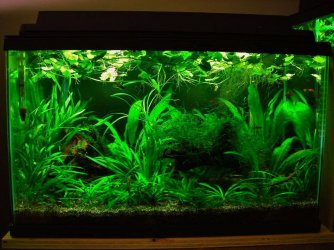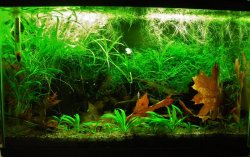You've touched on several issues since my last post, but I am also getting confused as there are references to the nano (the small) tank, and the larger, and questions on both together. The other thing is that trying to assess data from different threads can be confusing.
So first off, can we limit our discussions to just the small tank? And can you give us the tank dimensions and volume so we are all certain what we are discussing? The linked bulb for instance is probably going to be too bright, but I am not sure now what we are talking about.
I can answer a couple of your more general questions, though...on the liquid CO2, forget it. I can't remember if I mentioned in this thread about the toxicity of this stuff, but some brands at least are composed of glutaraldehyde which is a highly toxic disinfectant. Some plants will be killed at normal recommended doses, and if overdosed it will kill plants, fish and bacteria. I suspect it will be harmful to shrimp too. Keep in mind that every substance added to the water in an aquarium will get inside the fish because of natural processes, either by osmosis through the cells or via the gills. The less chemicals and additives, the better. Some can be deadly alone, but many when used together can be equally deadly as there are reactions.
JD dealt well with the CO2 diffusion. This is something you might consider for the larger tank, but we'll leave that for the present. I suggest dealing with the smaller tank here.
You won't need CO2. There is a fair bit of CO2 naturally produced, primarily in the substrate via the breakdown of organics by various bacteria. The normal respiration of fish, plants and some types of bacteria also produce CO2 but this is minimal by comparison. But once the tank is running for a spell, nature will sort all this out. The key to success with a planted tank is to have the light intensity sufficient to balance the CO2 and drive photosynthesis.
[Edit, it occurred to me that I could attach a couple photos of my smallest tank which is a 10g, to illustrate the sort of plant growth that is realistic with no CO2, 1/4 tsp of a comprehensive fert once a week, and two 9w CFL bulbs. The September photo is more recent, and this is not now a 'display' tank so it is a jumble of plants, because it is home to my colony of pygmy corys that spawn regularly and grow up in this environment, plus I do use it to grow out my Farlowella vitatta fry from time to time. So I tend to let it just "go." But the plant growth I think is good.]
You will likely need some fertilizer. In so small a tank, forget the dry. The complete liquids are much easier, and you use so little of them they are not particularly costly. Now some background on nutrients.
Aquatic plants require 17 nutrients, and to some degree these need to be balanced among themselves. Some nutrients if overdosed can cause plants to shut down assimilation of other nutrients, and algae can be a real problem. Unlike higher plants, algae is not at all fussy about light or nutrients, so it is always waiting to take advantage of imbalances. I tried to find data on the Neutro T you mention, but I can't find the ingredients and I would want to see this before recommending it or something else. [Definitely avoid their so-called liquid CO2 as from what they do say I am fairly certain this is likely glutaraldehyde.] But the Neutro T and/or Neutro+ might be OK if I can see what is in them. They do recommend dosing a lot though, and this bothers me.
Byron.


 /www.fishforums.net/index.php?/topic/439080-shrimp-tank/
/www.fishforums.net/index.php?/topic/439080-shrimp-tank/
